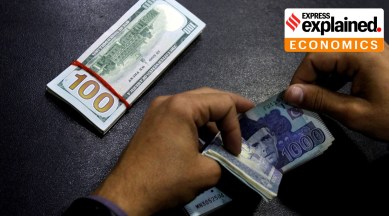Pakistan rupee plummets nearly 10%: What’s happening?
Pakistan’s economy has been in dire straits for a while, with the beleaguered nation looking for an IMF bailout to get out of the situation.

The Pakistani rupee plunged to a record low of Rs 255.43 against the dollar in the interbank market on Thursday, sliding Rs 24.54 or 9.61 per cent from yesterday’s close. This came after the removal of an “unofficial price cap on the exchange rate”, Dawn reported.
This is the largest single-day drop since 1999, when the new exchange rate system was first introduced.
monthly limit of free stories.
with an Express account.
The government reportedly relaxed its grip on the currency to avail much-needed loans from the IMF to rescue the crisis-stricken economy, Bloomberg reported.
Meeting the conditions for an IMF bailout
Dollar-strapped nations seeking aid from the IMF are facing growing pressure to allow market forces to play a greater role in setting their exchange rates. While Pakistan won a bailout last year, the IMF has delayed the release of further funds (amounting to nearly $ 6.7 billion) as the nation battles to keep its economy afloat amidst power outages, dollar shortages, sky-high inflation, and political tensions.
Financial analyst Saad Bin Naseer noted that one of the main requirements to complete the ninth review of the IMF programme, which would unlock $1.2 billion, was adherence to a market-based exchange rate.
Crucially, despite the crashing Pakistani rupee, Pakistan’s stock market showed positive signs. The benchmark KSE-100 index rose 2.4 per cent, the most in over five months. Experts pointed at this as evidence of Pakistan welcoming this move.
PKR expected to drop even further
“The rupee will continue to weaken and may hit 260 a dollar by end-June,” Amreen Soorani, head of research at JS Global Capital Ltd. in Karachi, told Bloomberg. “We are witnessing pressure on dollar reserves and there hasn’t been any fresh inflows that would give any meaningful increase to reserves,” he added.
With an acute dollar shortage in the country, currency is being exchanged in the black market, often at 10 per cent over its advertised rates.
An economy pushed to the edge by natural disaster
Pakistan’s economy was in a precarious situation long before the devastating 2022 floods threatened to push it over the edge. In 2019, IMF gave Pakistan an Extended Fund Facility to support its economy. However, the floods and other situational factors pushed Pakistan to renege on multiple terms of its deal with the IMF.
Thus, in November 2022, IMF refused to sanction its next round of funding, till Pakistan follows its terms – namely, increases energy rates, imposes more taxes, and ends artificial control over the exchange rate – all of which are seen to be politically unpopular.
While Pakistan has successfully courted friendly countries like UAE, China and Saudi Arabia for financial support, its economic situation has been such that securing help from the IMF is seen to be vital. While Shehbaz Sharif government’s removal of Pakistan’s artificially imposed cap on exchange rates has plunged its currency to a record low, it portends a softening of its stance viz a viz the IMF, with a resumption of the EFF on cards soon.